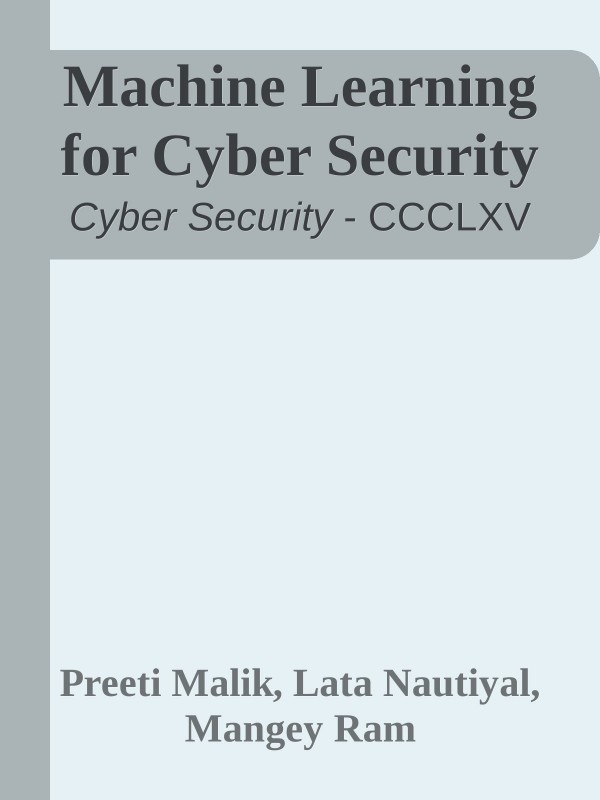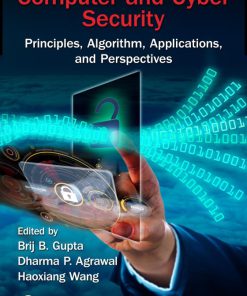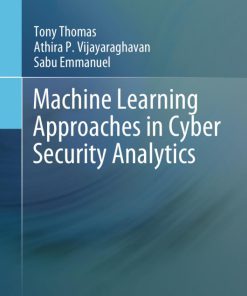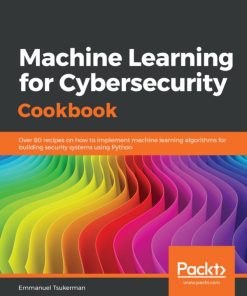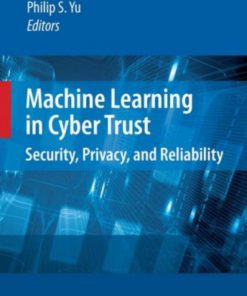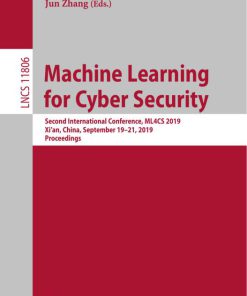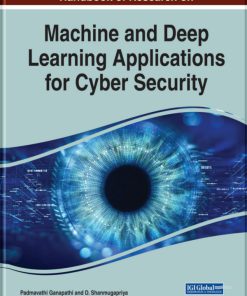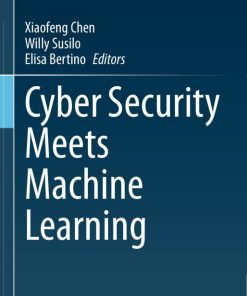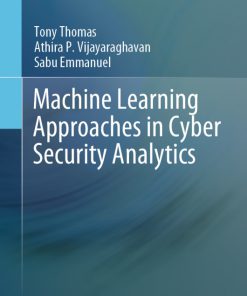Machine Learning for Cyber Security 1st edition by Preeti Malik, Lata Nautiyal, Mangey Ram 3110766736Â 978-3110766738
$50.00 Original price was: $50.00.$25.00Current price is: $25.00.
Authors:Preeti Malik, Lata Nautiyal, Mangey Ram , Series:Cyber Security [365] , Author sort:Preeti Malik, Lata Nautiyal, Mangey Ram , Languages:Languages:eng , Published:Published:Nov 2022 , Publisher:De Gruyter
Machine Learning for Cyber Security 1st edition by Preeti Malik, Lata Nautiyal, Mangey Ram – Ebook PDF Instant Download/DeliveryISBN: 3110766736, 978-3110766738
Full download Machine Learning for Cyber Security 1st edition after payment.
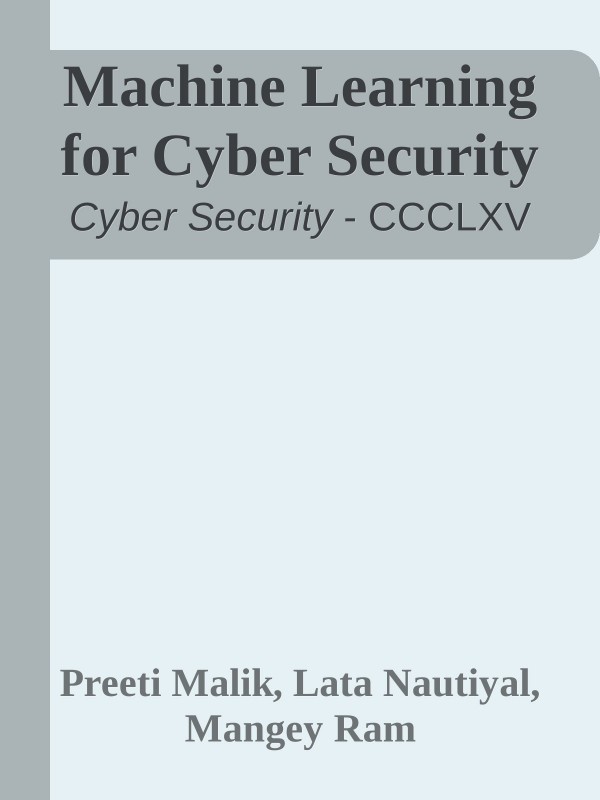
Product details:
ISBN-10 : 3110766736
ISBN-13 : 978-3110766738
Author : Preeti Malik, Lata Nautiyal, Mangey Ram
This book shows how machine learning (ML) methods can be used to enhance cyber security operations, including detection, modeling, monitoring as well as defense against threats to sensitive data and security systems. Filling an important gap between ML and cyber security communities, it discusses topics covering a wide range of modern and practical ML techniques, frameworks and tools.
Machine Learning for Cyber Security 1st Table of contents:
1 Social media and its popularity
1.1 Pandemic marketing update
1.2 Pros and cons of using social media
2 Social network analysis
3 Privacy breaches in social networks
3.1 Identity disclosure
3.2 Attribute disclosure
3.3 Social link disclosure
3.4 Affiliation link closure
4 Privacy preservation methods
4.1 Anonymization
4.2 k–Anonymity
4.3 Homogeneity attack
4.4 Background knowledge attack
4.5 l-Diversity
4.6 t-Closeness
5 Differential privacy
5.1 Types of differential privacy
6 Privacy attacks in social network
6.1 Private attribute inference
6.2 User de-anonymization attack
7 Application of differential privacy in social network analysis
7.1 Degree distribution
7.2 Subgraph counting
7.3 Edge weights
8 Summary
Abdul Rahman, Krishnadas Nanath Cracking Captcha using machine learning algorithms: an intersection of Captcha categories and ML algorithms
1 Introduction
2 Literature review
3 Category 1: theory-driven articles
4 Category 2: critical view of captcha
5 Category 3: supportive view of captcha
6 Category 4: other articles
7 Research method
8 Results and conclusion
List of acronyms
Kiran Aswal, Dinesh C. Dobhal, Umesh K. Tiwari, Heman Pathak The ransomware: an emerging security challenge to the cyberspace
1 Introduction
1.1 First-generation malware
1.2 Second-generation malware
2 Ransomware: an emerging threat to cyberspace
3 Evolution of the ransomware
4 Life cycle of the ransomware attack
4.1 Creation
4.2 Distribution
4.3 Execution
4.4 Destruction
4.5 Extortion
5 Handling a ransomware attack
5.1 Preventive measures to deal with ransomware attack
5.2 Detection and recovery of ransomware attack
6 Case study of WannaCry ransomware
6.1 Static and dynamic analysis of WannaCry
6.2 Life cycle of WannaCry
6.3 Indicator of compromise (IoC)
7 Conclusion
Samuel Wedaj Kibret Property-based attestation in device swarms: a machine learning approach
1 Introduction
1.1 Remote attestation of embedded devices
1.2 Outline
2 Problem definition, attack model, and assumptions
3 The proposed approach: ML for property-based attestation
3.1 Property fingerprinting
3.2 ML for property-based attestation
3.3 Decentralized swarm attestation
4 Implementation and performance evaluation
4.1 Proof of concept: ARM-based implementation
4.2 Performance evaluation
5 Security considerations
5.1 Attack threat model perspective
5.2 Implementation approach perspective
6 Related work
7 Protocol extensions
7.1 Device recovery
7.2 Code update
8 Conclusion
Notation
Acronyms
Sangeeta Mittal A review of machine learning techniques in cybersecurity and research opportunities
1 Introduction
2 Threats to cybersecurity and defense strategies
2.1 Threats to cybersecurity
2.2 Defense strategies for cybersecurity
3 Usage of machine learning in defense strategy implementations
4 Attack-wise ML-based defense strategies
4.1 Illicit access
4.2 Identity and information theft
4.3 Integrity attacks
4.4 Malware
4.5 Disruption of service
5 Limitations of machine learning-based solutions in cybersecurity
5.1 Data problems
5.2 Model problems
6 Opportunities for new ML paradigms
7 Conclusions
Vasu Thakur, Vikas Kumar Roy, Nikhil Baliyan, Nupur Goyal, Rahul Nijhawan A framework for seborrheic keratosis skin disease identification using Vision Transformer
1 Introduction
2 Literature review
3 Data collection
4 Methodology
5 Convolutional neural network (CNN)
5.1 VGG-19
5.2 Inception v3
6 Vision Transformer
7 Results and discussion
7.1 Why Vision Transformer?
8 Conclusion
Acronyms
Preeti Malik, Ashwini Kumar Singh, Rohit Nautiyal, Swati Rawat Mapping AICTE cybersecurity curriculum onto CyBOK: a case study
1 Introduction
2 What is body of knowledge (BOK)
2.1 Cybersecurity initiatives by All India Council for Technical Education (AICTE)
2.2 Foundation of CyBOK in national certification program for academic degrees in cybersecurity in the United Kingdom
3 CyBOK mapping framework
3.1 Mapping resources
3.2 Mapping process by using the CyBOK mapping framework and mapping resources
4 Mapping AICTE curriculum for undergraduate program
5 Results and discussion
6 Conclusion
People also search for Machine Learning for Cyber Security 1st:
game theory and machine learning for cyber security pdf
international conference on machine learning for cyber security
applied data science and machine learning for cyber security
modern approaches in iot and machine learning for cyber security
applied machine learning for cyber security

